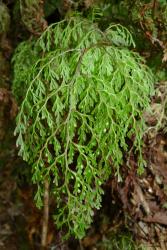Epiphytic, terrestrial or rupestral ferns. Rhizomes often long-creeping or occasionally erect, bearing multicellular hairs, lacking scales. Fronds monomorphic, not articulated to rhizome. Laminae undivided to 5-pinnatifid, or flabellate, digitate or dichotomously divided, anadromous or catadromous, membranous and usually one cell thick or occasionally 2–4 cells thick, often translucent, lacking stomata, glabrous or hairy. Veins free (NZ) or rarely anastomosing (not NZ). Sori terminal on veins at margins of lamina; paraphyses absent; indusia urceolate, campanulate, tubular or deeply bivalvate; receptacles short, capitate or clavate to long and exserted; maturation of sporangia gradate, developing basipetally. Sporangia with oblique annulus, 32–256 spores per sporangium. Homosporous; spores trilete, papillate to echinate, chlorophyllous.
A family with c. 600 species (Iwatsuki in Kramer & Green 1990). Nine genera have been proposed by Ebihara et al. (2006). However, in the interests of nomenclatural stability we prefer to recognise two traditional umbrella genera in New Zealand.
Numerous subdivisions of the Hymenophyllaceae have been proposed in the past resulting in several fundamentally different classifications. Most recently, the family has been revised by Ebihara et al. (2006). They recognised two major clades largely corresponding to the traditional umbrella genera, Hymenophyllum and Trichomanes, albeit with a few small groups transferred to the hymenophylloid lineage. The hymenophylloid clade appears to have diversified more recently than the trichomanoid clade, and displays less morphological variation and ecological diversification.
Ebihara et al. (2006) proposed a single genus (Hymenophyllum) for the hymenophylloid clade, with 10 subgenera. By contrast, they proposed eight genera (Abrodictyum, Callistopteris, Cephalomanes, Crepidomanes, Didymoglossum, Polyphlebium, Trichomanes and Vandenboschia) in the trichomanoid clade, each with one to four subgenera. The molecular phylogeny showed that the monotypic genus Cardiomanes, previously regarded as trichomanoid (Copeland 1933), actually belongs in the Hymenophyllum lineage. Nine genera were accepted by Smith et al. (2006).
If the subdivision of Hymenophyllaceae proposed by Ebihara et al. (2006) is accepted, the family is represented in New Zealand by four indigenous genera, Hymenophyllum, Abrodictyum, Polyphlebium, and Crepidomanes. However, it is virtually impossible to find macro-morphological characters that consistently discriminate these genera for all species. In New Zealand, where Hymenophyllaceae is the largest family of ferns, and many of the species are widespread, this is very unsatisfactory. Previously, two umbrella genera, Hymenophyllum and Trichomanes, have generally been recognised in New Zealand (Allan 1961; Brownsey et al. 1985; Brownsey & Smith-Dodsworth 2000), and the segregate genus Cardiomanes has sometimes been used for the distinctive endemic kidney fern (e.g. Crookes 1963). Since both Hymenophyllum and Trichomanes are monophyletic when interpreted broadly, and are generally readily distinguished morphologically, we prefer to retain them here. While the segregates of Trichomanes proposed by Ebihara et al. (2006) are all monophyletic, in the absence of a widely accepted criterion for ranking clades as genera, the interests of nomenclatural stability are best served with a broad Trichomanes.
Retaining Cardiomanes would make Hymenophyllum non-monophyletic as molecular evidence indicates that Hymenophyllum dilatatum, H. pulcherrimum and the South American H. fuciforme are more closely related to Cardiomanes than they are to other Hymenophyllum species (Schuettpelz & Pryer 2007; Hennequin et al. 2010). Consequently, we adopt the transfer of Cardiomanes to Hymenophyllum – as H. nephrophyllum – by Ebihara et al. (2006). However, the urceolate indusia with exserted receptacles and distinctive kidney-shaped lamina several cells thick in H. nephrophyllum make it anomalous within Hymenophyllum.
| 1 | Laminae undivided | Hymenophyllum |
| Laminae pinnately or dichotomously divided | 2 | |
| 2 | Indusia bivalvate; receptacles not or only slightly exserted; rhizomes nearly glabrous or only sparsely hairy | Hymenophyllum |
| Indusia tubular or campanulate; receptacles long-exserted; rhizomes abundantly covered in hairs | Trichomanes |
The Hymenophyllaceae comprises terrestrial or epiphytic ferns with long-creeping or erect rhizomes, an indumentum of hairs, membranous and often translucent laminae, marginal sori, tubular or bivalvate indusia, extended receptacles, sporangia with an oblique annulus, and trilete, green spores.
The family has its greatest diversity in tropical and south temperate regions, but a few species also extend into the north temperate zone. Two non-endemic genera with 31 species in New Zealand; 17 species endemic.
| Category | Number |
|---|---|
| Indigenous (Endemic) | 17 |
| Indigenous (Non-endemic) | 14 |
| Total | 31 |
The growth forms and distribution of species of Hymenophyllaceae in New Zealand, particularly in Westland, were analysed in detail by Holloway (1923, 1924). He also described the gametophytes and development of the sporophytes in H. nephrophyllum (as Cardiomanes reniforme) and Hymenophyllum pulcherrimum (Holloway 1930, 1944).




